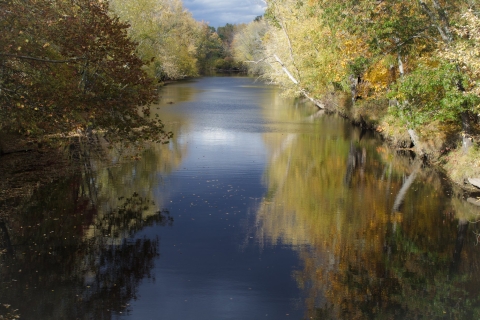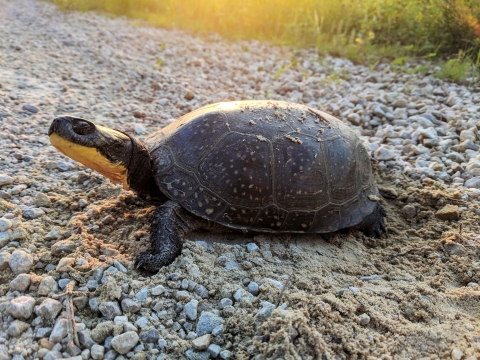Visit Us
National wildlife refuges offer us all a chance to unplug from the stresses of daily life and reconnect with our natural surroundings. There are numerous ways to enjoy the refuge. You can hike the five miles of trails along the riverbank, across oxbow ponds, and through wetland and forest habitat. You can check out educational and interpretative programs at the Bill Ashe Visitor Facility. To get a fantastic view of wildlife, launch your kayak from our boat launch and drift down the Nashua River.
Complex Headquarters
Assabet River National Wildlife Refuge serves as the headquarters for the Eastern Massachusetts National Wildlife Refuge Complex.
Email: fw5rw_emnwr@fws.gov
Phone: (978) 562-3527
Location and Contact Information
- Oxbow National Wildlife Refuge - Still River Depot RoadView Details33-1 Still River Depot Road Harvard, MA 01451-1420
- Oxbow National Wildlife Refuge - Bill Ashe Visitor Facility and Canoe LaunchView Details80 Hospital Rd Devens, MA 01434
About Us
Oxbow National Wildlife Refuge, is one of the eight refuges that make up the Eastern Massachusetts National Wildlife Refuge Complex. Historically, this land was first inhabited by Ingenious peoples of the region, then followed by the colonists and then the U.S. Army. Starting in 1917 this area was a part of Camp Devens, later to become Fort Devens. In 1974 after various land transfers, the refuge land was given to the U.S. Fish and Wildlife Service from the Department of Defense.
The U.S. Fish and Wildlife Service manage the refuge for an assortment of wildlife species, with special focus on migratory birds. Specifically, American woodcock and Massachusetts’s threaten Blanding’s turtle are important species for the refuge. Frequent residents of the refuge include white-tailed deer, fox, turkey, waterfowl, and various species of insects, amphibians, and reptiles. Oxbow, has a diverse array of habitats beneficial to wildlife, including wetlands, forested uplands, old fields, oxbow ponds and of course the Nashua River.
What We Do
Wildlife conservation is at the heart of the National Wildlife Refuge System. It drives everything on U.S. Fish and Wildlife Service lands and waters managed within the Refuge System, from the purposes for which a national wildlife refuge national wildlife refuge
A national wildlife refuge is typically a contiguous area of land and water managed by the U.S. Fish and Wildlife Service for the conservation and, where appropriate, restoration of fish, wildlife and plant resources and their habitats for the benefit of present and future generations of Americans.
Learn more about national wildlife refuge is established to the recreational activities offered to the resource management tools used. Using conservation best practices, the Refuge System manages Service lands and waters to help ensure the survival of native wildlife species.
Our Species
Oxbow National Wildlife Refuge was created for the conservation of a variety of wildlife species, with a special emphasis on migratory waterfowl and birds that are dependent on grassland and shrubland habitat. The refuge biologists conduct several population surveys focused on American woodcock, marsh birds, breeding birds, frogs, and toads. Oxbow currently supports the largest known population in the Northeast of the Massachusetts' threatened Blanding’s turtle. Oxbow is also attempting to control invasive species such as purple loosestrife in unique measures.
Projects and Research
Most research, projects, and initiatives on the refuges comprising the Eastern Massachusetts National Wildlife Refuge Complex examine management of avian resources, various public uses, rare, threatened, or endangered species and habitats, and invasive species invasive species
An invasive species is any plant or animal that has spread or been introduced into a new area where they are, or could, cause harm to the environment, economy, or human, animal, or plant health. Their unwelcome presence can destroy ecosystems and cost millions of dollars.
Learn more about invasive species control.






















